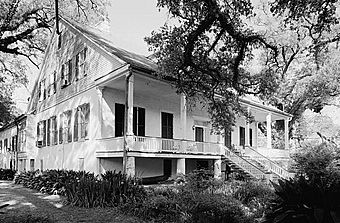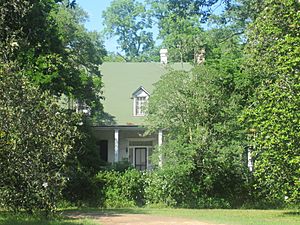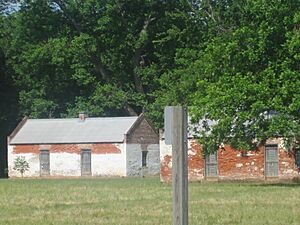Magnolia Plantation (Derry, Louisiana) facts for kids
|
Magnolia Plantation
|
|

Magnolia Plantation House
|
|
| Nearest city | Derry, Louisiana |
|---|---|
| Built | 1840 |
| Architectural style | Acadian Cottage |
| NRHP reference No. | 79001071 |
Quick facts for kids Significant dates |
|
| Added to NRHP | March 07, 1979 |
| Designated NHL | January 3, 2001 |

Magnolia Plantation is a historic cotton farm located in Natchitoches Parish, Louisiana. It's a special place because it shows what a large farm, called a plantation, was like in the 1800s. It still has many of its original buildings, including homes for the people who were enslaved there.
In 2001, Magnolia Plantation was named a National Historic Landmark. This means it is a very important historical site in the United States. It is also part of the Cane River Creole National Historical Park. You can visit it as part of the Louisiana African American Heritage Trail. Another plantation in the park is Oakland Plantation.
Contents
A Look Back: The Plantation's Story
This plantation's story began with Jean Baptiste LeComte II. He received land grants from France and Spain in the mid-1700s. However, the first buildings were not constructed until the 1800s. The plantation started operating around 1830.
Jean Baptiste's son, Ambrose LeComte, and his wife, Julia Buard, helped the plantation grow. Two of their daughters married into the Hertzog family. Atala LeComte and Matthew Hertzog took over the plantation in 1852. This is how the Hertzog family became linked to Magnolia.
By 1860, Ambrose LeComte II owned over 6,000 acres of land. On this land, 275 enslaved people were forced to work. They lived in 70 cabins and grew cotton and other crops.
Special Features of Magnolia Plantation
Magnolia Plantation is unique because it still has old farming tools and buildings. You can see early cotton picker tractors there. It also has two cotton gins, which are machines that separate cotton fibers from seeds. One was powered by steam, and the other by animals.
The plantation has 21 buildings that are important to its history. This is a lot for a plantation that still exists today. Among these are eight brick cabins. These were part of the original homes for the enslaved people. There were once 70 such cabins.
After the American Civil War, slavery ended. The cabins were then used by freedmen. These were Black people who had been enslaved and now worked as sharecroppers. Their families lived and worked on the plantation for another 100 years. As farming became more mechanized, fewer workers were needed. Because of this, fewer cabins were kept up.
Community Life at the Plantation
Magnolia Plantation was also important to the local community. The Civil War damaged the plantation house and other buildings. The Hertzog family had to rebuild them. For 100 years after the war, the "Hertzogs," as the place was known, was a center for many people. Black families and Creoles of color lived and worked there.
Most of the Black families were Protestant. The Creoles of color were mostly Catholic. They often leased land as tenant farmers. Everyone felt they had a part in keeping the land productive. By the mid-1900s, machines did more of the farm work. Many people left the plantation to find jobs in cities.
Sabin Gianelloni, Jr. bought some parts of Magnolia Plantation in 1951. However, members of the Hertzog family continued to own and live in the main house. Betty Hertzog was the last family member to live there, leaving in 2000. Today, a group called the Descendants of Ambrose John Hertzog and Sarah Jane Hunt Hertzog manages the house and farmland.
Visiting Magnolia Plantation Today
The National Park Service owns part of the plantation. This includes 16 buildings. Among these are the old plantation store, the cotton gin, and the Overseer's House (which was also used as a slave hospital). There is also a blacksmith shop and the brick cabins. The Park Service works to keep these buildings in good condition. This helps preserve them for people to learn from in the future.
On December 29, 2022, the main house and its surrounding land became part of the national historical park.
The Cane River Creole National Historical Park is located at 5487 Louisiana Highway 119. The closest town is Derry, Louisiana. The park is open from Monday to Friday, from 8 am to 4:30 pm.
See also
 In Spanish: Plantación Magnolia (Luisiana) para niños
In Spanish: Plantación Magnolia (Luisiana) para niños




